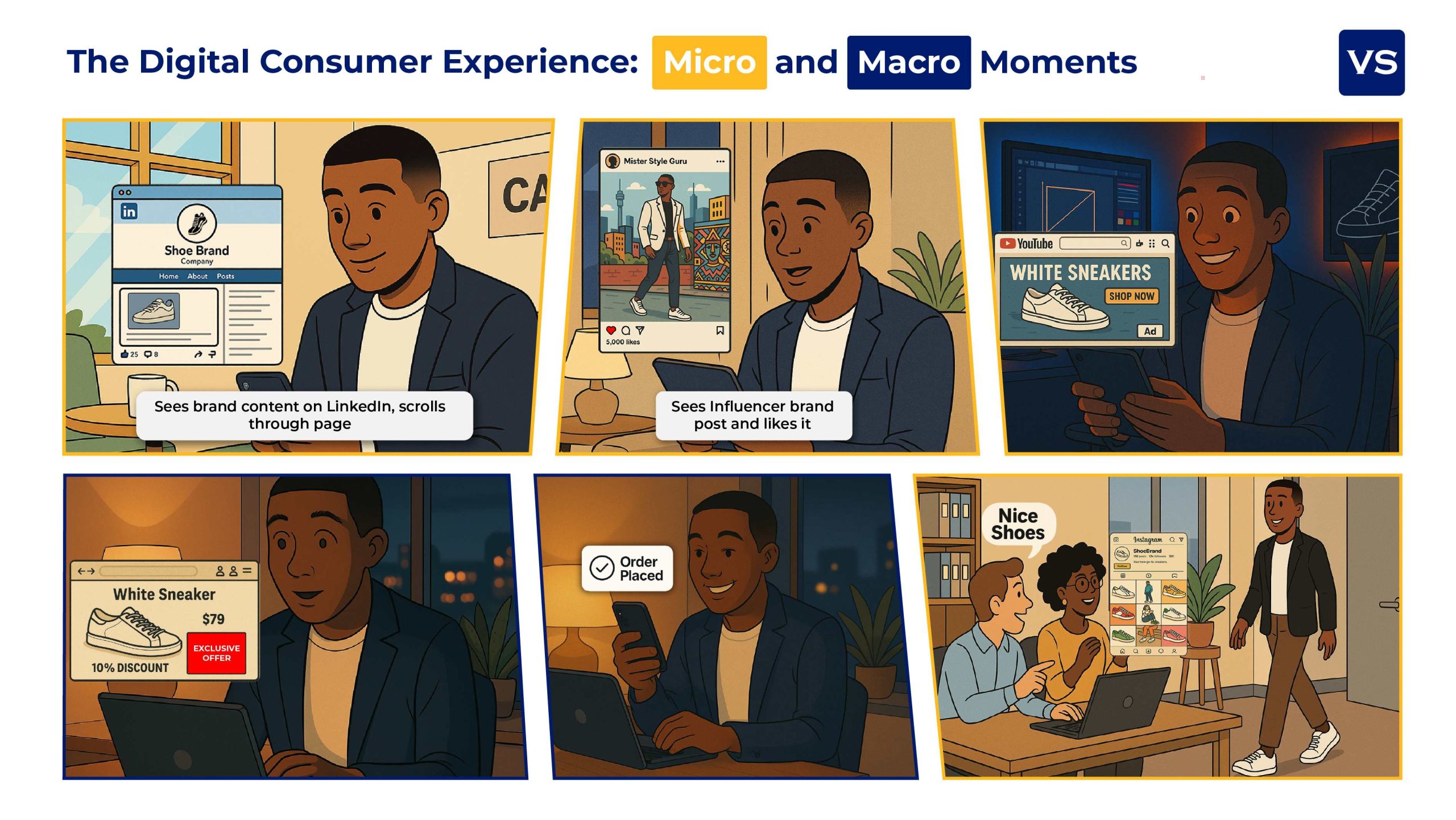THE DIGITAL CONSUMER EXPERIENCE JOURNEY: LEVERAGING MICRO AND MACRO MOMENTS
April 2025
In today’s fast-evolving digital landscape, brands are continuously refining their understanding of the digital consumer journey. Yet, traditional models still frame the user experience as a linear path—a straightforward progression from awareness to decision. However, the reality of consumer behavior is much more complex and dynamic. Rather than adhering to a fixed linear structure, digital experiences unfold in loops, sways, and sometimes even detours, making it essential for brands to rethink how they design and optimize their touchpoints.
One key framework to consider when evaluating digital journeys is the differentiation between Micro Moments and Macro Moments. These two types of interactions form the foundation of a more nuanced, behavior-driven journey—one that prioritizes momentum and engagement over simple progression.
What Are Micro and Macro Moments?
Micro Moments are brief, real-time, casual and seemingly instinctive digital interactions where users do things like watching a short video, reading a post, or clicking on a notification.
Macro Moments, on the other hand, are high-intent actions that reflect commitment like signing up for a webinar or newsletter, making a purchase, or booking a consultation.
Together, these moments shape the rhythm of a consumer’s journey – from curiosity to conversion. Micro Moments are about building momentum during the consideration phase, Macro Moments represent key moments of the conversion phase – when a consumer moves closer to a decision.
The Power of Micro and Macro Moments in The Digital Consumer Experience Journey
Micro Moments Build Momentum: Positive interactions in Micro Moments can help build momentum towards a larger action. For example, if a consumer engages with an informative blog post or watches a video tutorial about a product, they are subtly nudged toward a bigger decision later. These moments work together, shaping perceptions and influencing future behaviors.
Macro Moments Seal the Deal: On the other hand, Macro Moments are the final touchpoints where consumer intent is solidified. But what happens if a user encounters friction at these critical stages? A poor checkout experience, an unresponsive mobile page, or an irrelevant offer can easily derail the momentum that’s been built in the previous moments.
Here’s where understanding the continuity of the journey becomes critical. A successful digital experience doesn’t just drive users through individual touchpoints; it creates a seamless flow where each moment, whether Micro or Macro, feels like a natural progression.

How Can Brands Leverage Micro and Macro Moments?
1. Identify Where These Moments Happen
Look at your touchpoints. Are people watching reels, clicking blog links, or browsing FAQs? These are your Micro Moments. Are they adding items to carts or requesting demos? Those are your Macro Moments.
2. Optimize Micro Moments for Momentum
Once you’ve identified your Micro Moments, the next step is to optimize them for momentum. These moments should serve as small nudges that build toward larger actions. For example, deliver relevant, bite-sized content that encourages continued engagement and in formats such as stories, interactive posts,etc. These build trust and subtly guide the user forward
3. Optimize Macro Moments for Conversions
Remove friction at decision points. Simplify sign-ups, refine checkout flows, personalize offers. Every Macro Moment should feel like a natural next step, not a hurdle.
4. Use Data to Continuously Improve
Regularly analyze your touchpoints and consumer behavior data. Identify where the flow between Micro and Macro Moments falters. Are users abandoning their carts at checkout? Is there a drop-off after viewing a product video? This data will give you actionable insights for refining your journey and boosting both engagement and conversions.
5. Create Seamless, Cross-Platform Experiences
Today’s consumers engage with brands across a multitude of platforms: social media, websites, apps, email, and more. Each of these touchpoints can represent either a Micro or Macro Moment. Ensure that your messaging and experience are consistent across channels, with a focus on responsiveness and relevance to keep consumers moving smoothly through their journey.
6. Beyond the Linear Model: A New Approach to Consumer Journeys
The traditional A-to-B user journey model no longer suffices in a world where consumer behavior is non-linear and dynamic. Instead of thinking of the consumer experience as a funnel or a map, consider it as a momentum field – an environment where each touchpoint contributes to either building or draining energy. The goal is to create a digital ecosystem where every interaction feels seamless, relevant, and continuous, leading to higher engagement and increased conversions.
READ MORE
Want to learn more?

